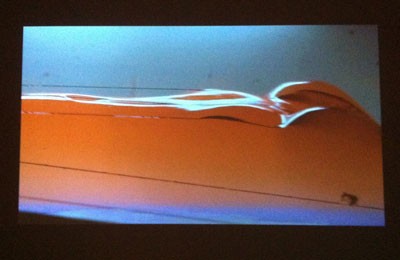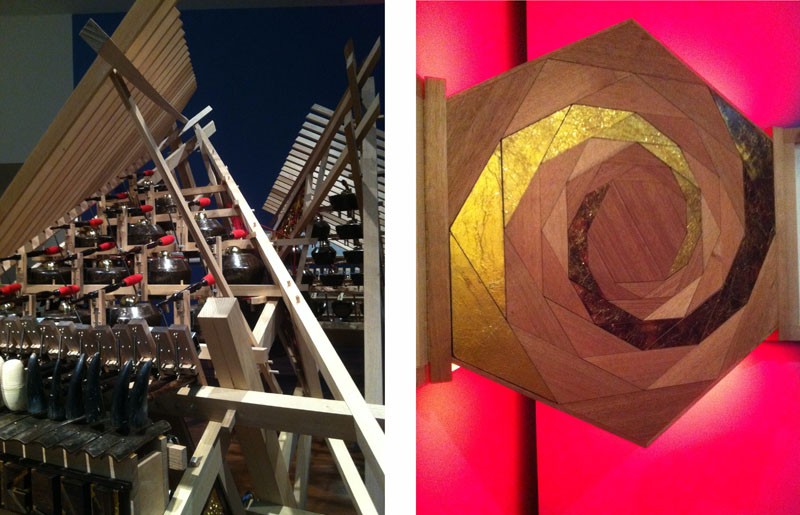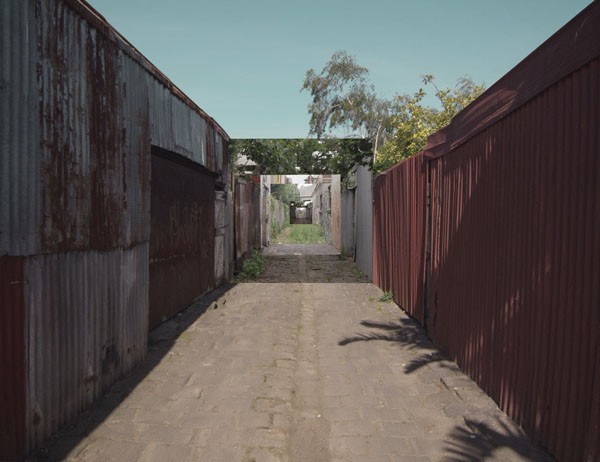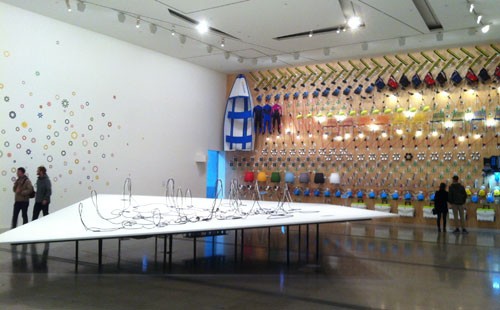MeNow part 1: Envy
So, I’ve been to MeNow — on a weekday and a weekend, wandering and poking and looking at crowds.
Big numbers
The NGV are rightfully chuffed with the big crowds. The opening weekend, 23-24 Nov, brought in 18,400 (ie, all Melbourne’s 18,400 practising artists, their families and frenemies) — bigger by between 200 to 2700 than the openings of Dutch Masters, Monet’s Garden, Picasso: Love & War, and Radiance: Neo-Impressionists.
The two-week total, as of 4 Dec, is spectacular: 71,900. The last few days and weekend (5-8 Dec) brought in another 22,000 to notch it up to 97,200 since opening on 22 Nov. The show runs till 23 Mar, so chances are it will bust a record and beat even the Australian-Pacific Triennale in Brisbane, which takes in 500,000 (APT@GOMA, NGV director Tony Ellwood’s last gig.)
But okay, apples and oranges: MeNow is free (as is GOMA’s APT); the other shows noted charged entries at about $20 a pop. And because MeNow is vast, taking up most of the temporary exhibition spaces right up to the entrance (like the APT) it would be impossible to enter the NGV St Kilda or Fed Square and not be counted as a MeNow visitor.
The sheer scale of the venture is striking. More figures: hard to nail down exactly but “more than 400” artists involved in “more than 175 individual and group presentations.” The resulting panoply is huge; the downloadable pdf of MeNow’s list of works goes to 120 pages.
One effect of so many participants is that you will — as I certainly did — see a good deal of, indeed, mostly, weak to middling stuff. Contemporary art is necessarily au courant, and a lot of that currency resides in fashion; the logic of fashion as relevance is inescapable, but that’s hardly a guarantee of quality. Anyway it is easy (as is the way of any anthology) to see how the selection might have replaced a whole bunch of artists here with a bunch of other artists.
Inclusivity and envy
Which is why I can understand how an exhibiting artist in this town NOT included in the survey might feel a little green or even furious. To miss out on being included in a historic survey — and thus into the historic catalogue (@$100 or the guide $10), Ouch-grrr!
When even, yes, even shoemakers and luggage designers, a professor of architecture (a wall of professorial doodles!), an art blogger, and a room cramming 30 sound artists via headphones (anyone listening?) make the cut into what has been curated as the most contemporary, most now, most hot — to be left out could well be embarrassing or insulting. (Artist: “Er, no, I didn’t get into MeNow, but hey you know, I’m like crazy busy already. Also right now I’m hanging in Berlin.”)
There can be no argument that a lot of perfectly MeNow-standard artists have not been “involved” (the generous layout of the elephantine show would be compromised by even more participants).
But that is exactly why the politics of inclusivity can result in envy. If the NGV curators had picked a mere fifty there might have been a few grumbles. To have included “more than 400” artists delivers a punch of grief to those who didn’t get a guernsey.
The Perpetual Now
There is one obvious fix (if you grant that there is an issue). As MeNow has been created with a biennale aesthetic, the NGV could produce it as a perpetual Now; every two or three years, long enough for the appetite to recover — with the next edition bringing in from the cold those (new younger, and getting even older) artists not in this year’s model. If the attendance figures turn out as well as they are tracking it’s a win-win. How about it?
+ + +
A shortlist of what I enjoyed at MeNow

Mark Hilton, don’t worry: Bottom left, the figure on the left side that looks like a hoisted rubbish bag references Michaelangelo’s self-portrait in the Last Judgement. Full marks for ambition!
Mark Hilton‘s amazing wall-filling resin bas relief don’tworry. Its encrusted stony grey letterforms have the uncanny effect of a gothic church facade’s sculptural ornamentation depicting bible stories. But Hilton’s piece is about his own coming of age story; he’s 37. I was very impressed by this work (it took five years to make) but felt also a slight queasiness — it’s like Kanye taking Strange Fruit and turning that touchstone anthem about race lynchings into a personal tale of romantic breakup (Blood on the Leaves). Also the funkily contemporary letterforms spelling a blithe ‘Don’t Worry’ is gonna become period real fast. A qualified Awesome.

Lucy McRae, Make your maker: Eat you.
Lucy McRae‘s Make your maker, a superbly produced 3min clip in a big dark room that I momentarily mistook for a Bjørk music video (high praise) with a dreamy, ominous soundtrack. The wall text says this “short film … made in collaboration with Nga/Nahji Chu of Australian restaurant Misschu, explores the inseparability of the body and food while also addressing body manipulation, cloning, consumption, gender, science, technology and evolution.” Nah, me neither, though you do see the girl eat with chopsticks a jelly mould of her face. And what if McCrae had used a fat ugly girl as the protagonist; wouldn’t that be better politics? Slight but very stylish.

Gareth Sansom, The Visitor: Trust me, I’m a surrealist.
Gareth Sansom‘s inimitably individualistic surrealism. At 74 Sansom is still one of the most thrilling painters we have; the array of surface treatments and detail, and complex shapes, and his hot popping colours. His pictures have always been willfully obscurantist but Sansom is now fashionably so as the rest have caught up to him. The painters’ painter.

Tony Garifalakis, Nazi Bloom: flower, er, power.
Tony Garifalakis‘ denim wall hangings. I’ve always liked these works — they have a distinctive insouciance; as if to say, right here right now how glib can we get and still be right on progressive yeah? (Still) groovy (for now).

Brad Westmoreland, Tree by the river: Old school but not old hat.
Brad Westmoreland paintings. I heard two young men — impeccably hipster — snide about this: “What the world needs, more art about art.” Actually, Westmoreland is way old-fashioned for 2013; his paintings would qualify for 100 year old (technically antique) postimpressionist — Fauve/Cubist category. Retro gold elephant stamp.

Slave Pianos, Gamelan sisters: Game lan on!
Slave Pianos (comprising Rohan Drape, Neil Kelly, Antanas Kesminas, Danius Kesminas, David Nelson, Michael Stevenson): Gamelan sisters (Sedulur gamelan) is a great crazy construction, like a Heath Robinson machine that’s a pianola with gamelan parts. With a long wall panel of music sheets and a Star Trek multichoice device to select the next sequence of harmonics — yes, I pressed it and a different set of soothing gamelan sounds were tapped out by the contraption. A woman and I stood there mesmerised while her husband blokily inspected the hammer mechanism. Wacky post-art.

Daniel Crooks, An embroidery of voids: Are we there yet? Are we there yet? Are we…
Daniel Crook‘s cut up video, An embroidery of voids. A quietly spectacular odyssey into Melbourne’s laneways and byways. Crook’s magically collaged piece with its slow dolly shots has something of the movie 2001‘s forward spirit into the unknown — the lanes as voids as inner space. Trophy for technical and conceptual brilliance.
+ + +

Jon Campbell, DUNNO (T. Towels): A Dingo Took My Baby.
A few of the other things I liked:
Moya McKenna‘s paintings, again a period feel, could be early C20; Linda Marinnon‘s and Stephen Benwell’s post-heroic ceramic figures; Jon Campbell‘s reworded tea towel frieze is naughty fun; Alan Constable’s ceramic cameras are delightful and possibly entirely irony-free; Charlie Sofo‘s video, 33 objects that can fit through a hole in my pocket, is as promised by Fairfax critic Robert Nelson, “brilliant and pointless” — which is tempting as a general, flattering summation.
+ + +

Anastasia Klose, One stop knock-off shop: Too critiquey for my shirt; too sexy for my critique.

A Constructed World, Amphorae: “reflects on the shift towards neoliberalism and economic rationalism.”

Julia deVille, Degustation: Eat me, I’m gluten-free.
A few emblematic examples of what I didn’t like:
Book, movie and music reviews are often harsh — something rather rare in the visual arts. But after all the art world is a small village and artists are sensitive flowers, no? Yeah but no, that also applies to writers et al. And yet, contemporary art loves to critique the world. Eg, from the wall text of Stieg Persson’s paintings at MeNow: “Here he critiques middle-class taste and affectation by presenting sweet images of fluffy kittens on cartoonish clouds which float behind lush gold renderings of grafitti…” No doubt Persson’s upper and middle-class collectors have a raffish chortle all to the way to the front desk where they pay for his work at the premium class Anna Schwartz Gallery — cos, it’s not about them, is it? Anyway.
Anastasia Klose‘s One stop knock-off shop — knock-off in more than one sense; see Takashi Murakami’s pioneering sellout where he simultaneously critiqued and coopted capitalism, Louis Vuitton, museum and art consumer culture back in 2007-08 in LA and Brooklyn; but then a lot of art in MeNow is thin and derivative. The Klose t-shirts and mugs for sale sport juvenile, artworld sneers: Andy Warshole; Claude Monéy, Marcel Dachump, Anastasia Klothes (she can so take a joke).
A constructed world (Geoff Lowe and Jacqueline Riva) — painting, video and plastic amphorae. Lowe once painted well but this assembly (not quite an installation) seems typical of much tedious, impenetrable contemporary art. JMW Turner once contemptuously teased a viewer not to get too close as they might get paint on their clothes. Perhaps we shouldn’t get too close to some contemporary art in case we get Theory on our noses.
Julia deVille’s installation, Degustation. Taxidermy hipster art. (Post-trendy, we’re all just hip.) Cute animals, but can dead still be cute? How cute can hipster get? Can hipster be dead and still cute? Can hamsters be hipsters? So many questions to interrogate.











Crikey is committed to hosting lively discussions. Help us keep the conversation useful, interesting and welcoming. We aim to publish comments quickly in the interest of promoting robust conversation, but we’re a small team and we deploy filters to protect against legal risk. Occasionally your comment may be held up while we review, but we’re working as fast as we can to keep the conversation rolling.
The Crikey comment section is members-only content. Please subscribe to leave a comment.
The Crikey comment section is members-only content. Please login to leave a comment.